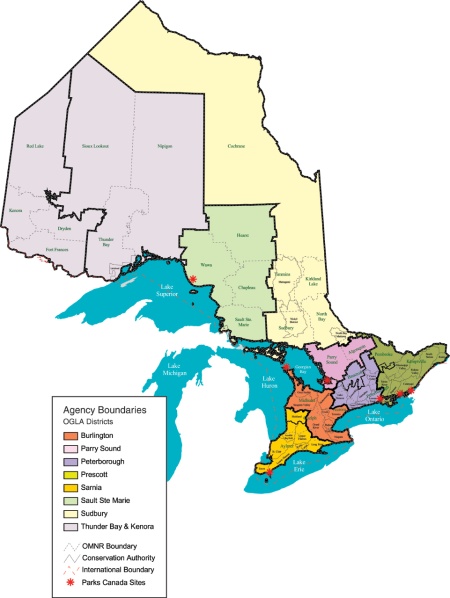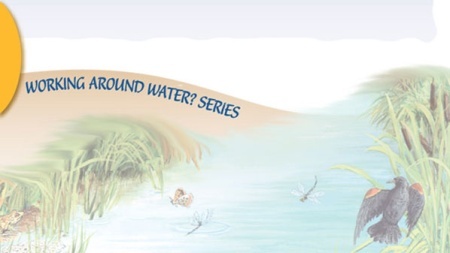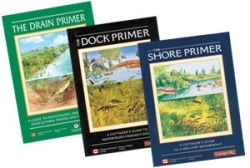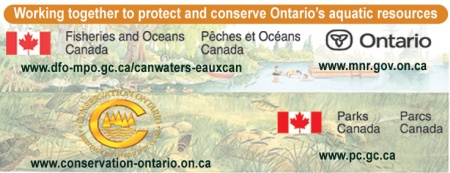| Français | Contact Us | Help | Search | Canada Site | |||||
| Home | About Us | What's New? | Site Map | DFO Home | |||||
| Science | Fisheries | Canadian Coast Guard |
Media | Policy | |||||
| Habitat | Oceans | Library | Publications |
|
Information Fact Sheet C-1 Fact Sheet C-2 Fact Sheet C-3 Fact Sheet C-4 Fact Sheet C-5 Fact Sheet I-1 Fact Sheet I-2 Fact Sheet I-3 Fact Sheet I-4 Fact Sheet L-1 Fact Sheet L-2 Fact Sheet T-1 Fact Sheet T-2 |
Home: Publications: Fact Sheet Series: What you should know about fish habitat


This introductory fact sheet in the Working Around Water? series describes the different authorities to contact and the legislation that may apply in your province for works occuring in and around water. The Working Around Water? series of fact sheets provide information on fish habitat to assist you in the planning and approvals processes necessary for different types of work projects and more detailed general information that may affect fish habitat. The fact sheets also outline best practices for common waterfront projects, such as boat house and dock construction, building beaches, controlling aquatic plants, dredging, shoreline construction, erosion control and shoreline restoration. Whatever your project, our fact sheets can help by explaining who to contact and how to undertake it in a way that is environmentally sound. You can help safeguard the fish in your lake or river and protect fish habitat along your waterfront by carefully planning work projects. Protecting fish habitat and the Fisheries Act
To ensure that fish habitat is protected, your local provincial regulatory authority(ies), Parks Canada Agency (PCA) sites and Fisheries and Oceans Canada (DFO) all have legal requirements you should be aware of before you start your work project. These requirements may affect how you should proceed with any planned projects in and around water. For most work projects, you must obtain work permits as required under provincial and federal legislation. Additionally, the federal Fisheries Act provides for the protection of fish habitat. Under the Fisheries Act, no one may carry out any work or undertaking that results in the harmful alteration, disruption or destruction of fish habitat (HADD), unless this HADD has been authorized by the Minister of Fisheries and Oceans Canada. Fisheries Act authorizations may also be required if your project involves blasting in or near water, killing fish by means other than fishing, or creating a barrier to fish migration. Only the Minister of Fisheries and Oceans Canada can authorize these activities. The Act also states that no one is permitted to deposit a deleterious (harmful) substance into water containing fish. For more details on Fisheries Act authorizations, please see the brochures: What the Law Requires, and Guidelines for Attaining No Net Loss, prepared by DFO. These brochures provide information about the kinds of activities that could adversely affect fish and fish habitat, and explain your responsibilities under the Fisheries Act. In some instances, additional approvals may be required. For example, some docks may need to be approved by the DFO - Canadian Coast Guard due to navigation concerns under the Navigable Waters Protection Act. The process can take a while so you should apply for approvals early! Obtaining approvals - information requirementsWhether applying for provincial or federal work permits or approvals, you will be asked for specific information about your proposed work project. The project can be assessed and approved more efficiently when accurate and detailed information is provided. Therefore, always be sure to include the following basic information with your application:
A site visit by agency staff will often be necessary to assess your application. Obtaining work permitsYou may require a work permit from the provincial regulatory authority(ies). This (these) permit(s) must be obtained before you start any work. Depending on where the project will be undertaken, your application will be reviewed by the provincial regulatory authority(ies) in that area or you will be advised of the appropriate agency to contact. The provincial legislations that apply in Ontario are described on the last page. Work permits may include conditions, such as the time of year when your work can be done. Read your permit carefully. If you cannot comply with all the conditions, you should not begin the work. Contact your provincial regulatory authority(ies) staff immediately for assistance. In those situations where a work permit is not necessary, we suggest you carefully follow the best management practices provided in our fact sheets to ensure that fish habitat will be protected. Federal legislation with implications for work in and around waterFederally, several pieces of legislation exist to safeguard fish habitat and protect public rights. These include: The Fisheries Act Violations to the Act can result in substantial fines and/or risk of imprisonment. If found guilty, then the violator may also be required to cover the costs of restoring the habitat at the site and/or be required to fulfill other court ordered remedies. An authorization is required before undertaking any work that may cause a HADD. The Historic Canals Regulations and the National Parks Act The beds of the lakes, rivers, streams and other water bodies within these sites are owned and administered by Parks Canada on behalf of Canadians. Therefore, projects or works in or directly adjacent to waters on these federal lands are to be referred to Parks Canada for their review and approval. The Navigable Waters Protection Act What is Fish Habitat?Fish habitat is any component of an aquatic system that provides any one of the following: Cover: Cover provides areas for escape from predators, competitors and high flows. Numerous forms of cover exists including substrate, woody debris, undercut banks and even deep water. Food: Fish require food in adequate amounts to survive and reproduce. The type and amount of food produced is dependent upon the substrate and riparian characteristics of the watercourse. Reproduction: Fish require adequate substrate and water quality for successful reproduction. Water quality: Most species have specific temperature ranges in which they can live. Changes to riparian vegetation and width to depth ratio can alter watercourse temperatures. The introduction of sediment, pesticides or any other deleterious substances degrades water quality. Migration routes: Fish often travel great distances within a watercourse for both spawning and feeding. Any activity or structure that blocks migration can detrimentally affect fish populations.
Fisheries and Oceans Canada, Ontario-Great Lakes area
To view the complete list of Working Around Water? Fact Sheets and other Fisheries and Oceans Canada publications available, visit our web site at www.dfo-mpo.gc.ca/canwaters-eauxcan and choose the "nfocentre" option followed by "Guidelines & Factsheets". 
Provincial legislation with implications for work in and around water in OntarioThe Public Lands Act The Lakes and Rivers Improvement Act The Conservation Authorities Act Your first contact for approvals and permits in OntarioStart by contacting one of the following agencies in your area:
Whatever agency you contact first, whether it is your local CA, OMNR or PCA office, they can help you determine which requirements apply to your specific project. The provincial regulatory authority(ies) in your area will guide you through the process of obtaining all necessary approvals required under provincial and federal legislation. They can also help you select the best methods to undertake your project in a way that is safe for the environment. PRIMERS ARE AVAILABLE FOR COMMON WATERFRONT PROJECTS
For an electronic copy of the Drain, Dock or Shore Primer, visit the Fisheries and Oceans Canada web site below and choose the "Infocentre" option followed by "Guidelines & Factsheets". Working together to protect fish habitatA goal of fisheries management programs is to achieve a net gain in fish habitat. You can help accomplish this goal by working with agency staff to ensure that fish populations in our lakes, rivers and streams are sustained for future generations. Other Working Around Water Fact Sheets:
What you should know about Fish Habitat
www.dfo-mpo.gc.ca/canwaters-eauxcan 
| |||||||
| Last updated: 2004-09-17 |
|
Important Notices | |